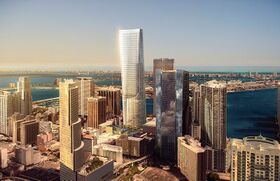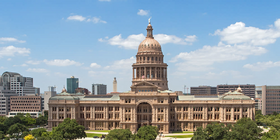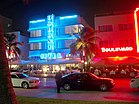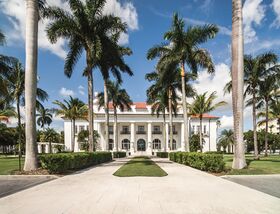Ponto Solar: Difference between revisions
(Created page with "{{WIP}} {{Region icon Kylaris}} {{Infobox settlement | name = Ponto Solar | native_name = | native_name_lang = <!-- ISO 639-2 code e.g....") |
No edit summary |
||
| (One intermediate revision by the same user not shown) | |||
| Line 124: | Line 124: | ||
}} | }} | ||
'''Ponto Solar''', officially the '''Capital Metropolis of Ponto Solar''' ({{wpl|Portuguese language|Luzelese}}: ''Metrópole Capital de Ponto Solar'') and archaically '''San Felix''', is the {{wp|Capital city|capital}} and largest city of [[Arbolada]], in addition to being the sole major constituency in the [[Ponto Solar Capital District]]. In 2020, the city had 2.2 million inhabitants; the city is considered the lynchpin of the [[Florestas Verdes-Ponto Solar-Calusa metropolitan area]], which contains a population numbering more than 10 million (making it one of the most populous metropolitan areas in [[Asteria Inferior]], and holding nearly half of the population of Arbolada within). Ponto Solar is located on the coast of south-central Arbolada, sitting next to the [[Lumine Ocean]] via the [[Gulf of Good Tidings]]. | '''Ponto Solar''', officially the '''Capital Metropolis of Ponto Solar''' ({{wpl|Portuguese language|Luzelese}}: ''Metrópole Capital de Ponto Solar'') and archaically as '''San Felix''', is the {{wp|Capital city|capital}} and largest city of [[Arbolada]], in addition to being the sole major constituency in the [[Ponto Solar Capital District]]. In 2020, the city had 2.2 million inhabitants; the city is considered the lynchpin of the [[Florestas Verdes-Ponto Solar-Calusa metropolitan area]], which contains a population numbering more than 10 million (making it one of the most populous metropolitan areas in [[Asteria Inferior]], and holding nearly half of the population of Arbolada within). Ponto Solar is located on the coast of south-central Arbolada, sitting next to the [[Lumine Ocean]] via the [[Gulf of Good Tidings]]. | ||
The city was originally formed in 1566 as a colony of [[Paretia]], christened San Felix by its Esmeiran founder [[Tadeo Mandujano]]. It thus became a hub of Luzelan and Esmeiran immigration into Asteria Inferior. Following his death, the [[Viceroyalty of San Felix]] was formed, with the eponymous settlement becoming the colony's economic and population center. It remained the capital of the newly-founded [[United Republic of Arbolada]] in 1784 following the [[Arboladan War of Independence]]. Growing only further due to immigration from other continents and from the inland settlements, San Felix was eventually rechristened as Ponto Solar, or Sunpoint, by President [[Horacio Sallent]] in 1864. As the 20th century approached, the city's continued growth and importance forced the national government to partition the city's territory from the rest of the [[San Felix(prefecture)|San Felix prefecture]], thereby creating the Capital Metropolis area by 1938. | The city was originally formed in 1566 as a colony of [[Paretia]], christened San Felix by its Esmeiran founder [[Tadeo Mandujano]]. It thus became a hub of Luzelan and Esmeiran immigration into Asteria Inferior. Following his death, the [[Viceroyalty of San Felix]] was formed, with the eponymous settlement becoming the colony's economic and population center. It remained the capital of the newly-founded [[United Republic of Arbolada]] in 1784 following the [[Arboladan War of Independence]]. Growing only further due to immigration from other continents and from the inland settlements, San Felix was eventually rechristened as Ponto Solar, or Sunpoint, by President [[Horacio Sallent]] in 1864. As the 20th century approached, the city's continued growth and importance forced the national government to partition the city's territory from the rest of the [[San Felix(prefecture)|San Felix prefecture]], thereby creating the Capital Metropolis area by 1938. | ||
| Line 138: | Line 138: | ||
===Prehistory=== | ===Prehistory=== | ||
==Geography | ==Geography== | ||
=== | ===Neighborhoods=== | ||
===Architecture=== | |||
===Climate=== | ===Climate=== | ||
== | ===Parks=== | ||
===Military installations=== | |||
=== | ==Demographics== | ||
===Population density=== | |||
===Race and ethnicity=== | |||
===Sexual orientation and gender identity=== | |||
===Religion=== | |||
== | ====Sotirianity==== | ||
== | ===Wealth and income disparity=== | ||
==Economy== | ==Economy== | ||
==Culture and | ===Tech and biotech=== | ||
===Real estate=== | |||
===Tourism=== | |||
===Media and entertainment=== | |||
===Climate resiliency=== | |||
==Education== | |||
===Primary and secondary education=== | |||
===Higher education and research=== | |||
==Human resources== | |||
===Public health=== | |||
===Public safety=== | |||
====Police and law enforcement==== | |||
====Firefighting==== | |||
===Public library system=== | |||
==Culture and contemporary life== | |||
===Pace=== | |||
===Arts=== | |||
====Performing arts==== | |||
====Visual arts==== | |||
===Shopping | ===Shopping=== | ||
=== | ===Cuisine=== | ||
===Historic and religious sites=== | ===Historic and religious sites=== | ||
| Line 164: | Line 212: | ||
===Museums=== | ===Museums=== | ||
===Festivals=== | ===Festivals and parades=== | ||
===Accent and dialect=== | |||
===Sports=== | ===Sports=== | ||
=== | ====Baseball==== | ||
====Hockey==== | |||
====Soccer==== | |||
====Tennis==== | |||
====International events==== | |||
===In popular culture=== | ===In popular culture=== | ||
== | ==Environment== | ||
===Environment impact reduction=== | |||
===Water purity and availability=== | |||
===Air quality=== | |||
===Environment revitalization=== | |||
==Government and politics== | |||
===Government=== | |||
===Politics=== | |||
==Transportation== | ==Transportation== | ||
== | ===Rapid transit=== | ||
====Rail==== | |||
====Buses==== | |||
===Air=== | |||
===Ferries=== | |||
===Taxis, vehicles for hire, and trams=== | |||
===Streets and highways=== | |||
====River crossings==== | |||
===Cycling network=== | |||
==People== | |||
{{main|List of people from Ponto Solar}} | |||
==Global outreach== | |||
===Sister cities=== | ===Sister cities=== | ||
Latest revision as of 01:37, 16 April 2023
This article is incomplete because it is pending further input from participants, or it is a work-in-progress by one author. Please comment on this article's talk page to share your input, comments and questions. Note: To contribute to this article, you may need to seek help from the author(s) of this page. |
Ponto Solar | |
|---|---|
Metropolis | |
| Nickname(s): PS, Sunpoint, Sonnenpunkt | |
| Motto(s): Sempre iluminando o futuro "Always illuminating the future" | |
| Country | |
| Prefecture | Ponto Solar Capital District |
| Founded by | Tadeo Mandujano |
| Government | |
| • Type | Mayor-commission |
| • Body | Ponto Solar Metropolitan Council |
| • Mayor | João da Silva (PRL) |
| Population (2020) | |
| • Total | 2,200,000 |
| Demonym | Ponto Solarian |
| Time zone | UTC+15 |
| Website | pontosolar.ab |
Ponto Solar, officially the Capital Metropolis of Ponto Solar (Luzelese: Metrópole Capital de Ponto Solar) and archaically as San Felix, is the capital and largest city of Arbolada, in addition to being the sole major constituency in the Ponto Solar Capital District. In 2020, the city had 2.2 million inhabitants; the city is considered the lynchpin of the Florestas Verdes-Ponto Solar-Calusa metropolitan area, which contains a population numbering more than 10 million (making it one of the most populous metropolitan areas in Asteria Inferior, and holding nearly half of the population of Arbolada within). Ponto Solar is located on the coast of south-central Arbolada, sitting next to the Lumine Ocean via the Gulf of Good Tidings.
The city was originally formed in 1566 as a colony of Paretia, christened San Felix by its Esmeiran founder Tadeo Mandujano. It thus became a hub of Luzelan and Esmeiran immigration into Asteria Inferior. Following his death, the Viceroyalty of San Felix was formed, with the eponymous settlement becoming the colony's economic and population center. It remained the capital of the newly-founded United Republic of Arbolada in 1784 following the Arboladan War of Independence. Growing only further due to immigration from other continents and from the inland settlements, San Felix was eventually rechristened as Ponto Solar, or Sunpoint, by President Horacio Sallent in 1864. As the 20th century approached, the city's continued growth and importance forced the national government to partition the city's territory from the rest of the San Felix prefecture, thereby creating the Capital Metropolis area by 1938.
Throughout the presidential tenures of figures such as Nikolai Vorobev and Paul Bacharach, the city saw continued modernization and expansion, including the conception of the Florestas Verdes-Ponto Solar-Calusa metropolitan area which saw the coastal urban landscape of Ponto Solar reach towards the two other major Arboladan cities. By the turn of the 21st century, Ponto Solar had become one of the most populous, richest, and most influential cities in Asteria Inferior, with its massive municipal economy being fed by Arbolada's interior industries and that of tourism and finance.
Ponto Solar is considered to be a beta + city due to its rigorous connection to global trade and travel, and simultaneously functions as the transportation hub for almost all of Arbolada through its rail, highway, and airport connections. It is also home to the Arboladan Stock Exchange and hosts the headquarters of various major Arboladan companies. Being the executive, judicial, and legislative capital of the country, it is also host to the headquarters of all government institutions, including the Golden Capitol and the President of Arbolada's residence in the Arboladan Presidential Mansion. The city functions as one of Arbolada's major tourist magnets as a result of its boisterous nightlife, environmental and recreational attractions, and major landmarks. Ponto Solar also functions as one of Asteria Inferior's major research centers, with universities such as the Ponto Solar University and University of Arbolada offering high-class academia.






